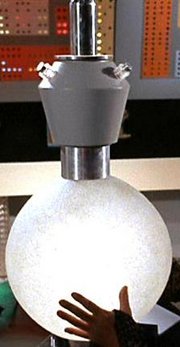|
Cloaking Technology |
|
|
..
Invisibility Shields Planned
by Engineers
But is the idea really so implausible? Not according to new findings by scientists who say they have come up with a way to create cloaking device. Electronic engineers at the University of Pennsylvania in Philadelphia are researching a device they say could make objects "nearly invisible to an observer." The contrivance works by preventing light from bouncing off the surface of an object, causing the object to appear so small it all but disappears. The concept was reported today by the science news Web site news@nature.com. It says the proposed cloaking device would not require any peripheral attachments (such as antennas or computer networks) and would reduce visibility no matter what angle an object is viewed at. Sir John Pendry, a physicist at Imperial College, London, said the concept potentially holds several important applications "in stealth technology and camouflage." While types of invisibility shielding have been developed before, the phenomenon described by Andrea Alú and Nader Engheta sounds like something that might have been witnessed from the bridge of science fiction's starship Enterprise. The concept is based on a "plasmonic cover," which is a means to prevent light from scattering. (It is light bouncing off an object that makes it visible to an observer). The cover would stop light from scattering by resonating at the same frequency as the light striking it. If such a device could cope with different wavelengths of electromagnetic radiation (including visible light), in theory, the object would vanish into thin air. Plasmonic Covers Alú and Engheta investigated experimental plasmonic covers that incorporated metals, such as gold and silver, to hide visible light. When light strikes a metallic material, waves of electrons, called plasmons, are generated. The engineers found that when the frequency of the light striking the material matched the frequency of the plasmons, the two frequencies act to cancel each other out. Under such conditions, the metallic object scattered only negligible amounts of light. The researchers' studies show that spherical and cylindrical objects coated with plasmonic shielding material produce very little light scattering. These objects, when hit by the right wavelength of light, were seen to become so small that they were almost invisible. The study is supported by the U.S. Defense Advanced Research Projects Agency, which researches and develops cutting edge military technology. Some experts note, however, that cloaking devices that could enable military vehicles and aircraft, let alone spaceships, to become completely invisible to the enemy are likely to remain elusive for the foreseeable future. John Pendry, the Imperial College physicist, said that light-shielding covers would have to be customized to match the properties of each and every object they hide. It would be still more difficult to devise shields that could cope with all wavelengths of the visible spectrum—from red to violet light—and not just a single color. Types of invisibility shielding previously proposed by scientists depend on advanced camouflage systems, rather than objects being made to look undetectably tiny. Such systems involve light sensors that create a mirror image of the background scene on the concealed object. SOURCE: National Geographic |
|
| FAIR USE NOTICE: This page contains copyrighted material the use of which has not been specifically authorized by the copyright owner. Pegasus Research Consortium distributes this material without profit to those who have expressed a prior interest in receiving the included information for research and educational purposes. We believe this constitutes a fair use of any such copyrighted material as provided for in 17 U.S.C § 107. If you wish to use copyrighted material from this site for purposes of your own that go beyond fair use, you must obtain permission from the copyright owner. | |
|
|

